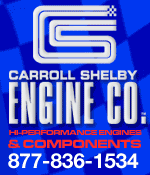Welcome to Club Cobra! The World's largest
non biased Shelby Cobra related site!
- » Representation from nearly all
Cobra/Daytona/GT40 manufacturers
- » Help from all over the world for your
questions
- » Build logs for you and all members
- » Blogs
- » Image Gallery
- » Many thousands of members and nearly 1
million posts!
YES! I want to register an account for free right now!
p.s.: For registered members this ad will NOT show
 
 Main Menu
Main Menu
|
 Nevada Classics
Nevada Classics
|
 Advertise at CC
Advertise at CC
|
 December 2024
December 2024
|
| S |
M |
T |
W |
T |
F |
S |
| 1 |
2 |
3 |
4 |
5 |
6 |
7 |
| 8 |
9 |
10 |
11 |
12 |
13 |
14 |
| 15 |
16 |
17 |
18 |
19 |
20 |
21 |
| 22 |
23 |
24 |
25 |
26 |
27 |
28 |
| 29 |
30 |
31 |
|
|
|
|
|
 CC Advertisers
CC Advertisers
|
|
 11Likes 11Likes

01-02-2023, 05:18 PM
|
|
CC Member

|
|
|
Join Date: Dec 2001
Location: Louisville,
KY
Cobra Make, Engine: I'm Cobra-less!
Posts: 9,417
|
|

 Neutral
Neutral

Lowering the LSA doesn't always mean you'll get a nasty idle.
Overlap is what you hear and just because a cam is a 104, 106, or 108 (or anything in between) LSA, doesn't mean it will have a nasty idle.
I can grind a very tight advertised duration, small .050" duration camshaft on a 104 LSA and it will not thump. Or.....I can grind a very large advertised duration on a 114 LSA and it will sound completely nasty.
Multiple variables play into how much overlap (sound) you have. The LSA is just one of them and isn't the major proponent.
In addition to all of that, it's generally thought of that a 110 LSA is a "good street cam", a 112-114 is "an EFI cam", a 108 is a "drag race cam" and a 106 is a "circle track cam". Those thoughts and ways of thinking couldn't be further from actuality/reality. Widening the LSA doesn't always mean it will have a smooth idle and narrowing the LSA doesn't always mean it will have a rowdy idle. My pulling truck camshafts are on 119-121 lobe separation angles and sound like the engine is leaving the face of the earth.
Thumpr cams sound like they do not just because the LSA is on a 107, but because the advertised durations are very high as well. These cams have overlap numbers in the 90's. They are made for pure sound, not efficiency or horsepower. As a matter of fact, for anything but the most horrible performing factory heads, they are putting more horsepower out the exhaust than making it usable.
www.customfordcams.com
Last edited by blykins; 01-02-2023 at 05:24 PM..
|
-
Advertising


01-02-2023, 10:11 PM
|
 |
CC Member

|
|
|
Join Date: Aug 2009
Location: Adelaide,
SA
Cobra Make, Engine: AP 289FIA 'English' spec.
Posts: 13,152
|
|

 Not Ranked
Not Ranked
Quote:
Originally Posted by TassieCobra

.... Addit:
Thanks to everyone for all of the great advice. To give more information I am based in Australia (Victoria or Tasmania for registration purposes). I am looking at a higher end Cobra build with an aluminium body. The manufacturer can accommodate a variety engine choices/mounts. As pointed out though I suspect we will have more stringent emission requirements etc.....
|
Hello again TassieCobra. Going sideways only slightly....can you tell us more about your Cobra build?
You mentioned a "higher end Cobra build with an aluminium body" .... just wondering, is it an AP variant, with a Kirkham body on an AP aluminium alloy monocoque? Curiosity piqued 
Cheers!
Glen |

01-03-2023, 01:52 PM
|
|
CC Member

|
|
|
Join Date: Nov 2018
Location: Priceville,
al
Cobra Make, Engine: Unique FIA
Posts: 334
|
|

 Not Ranked
Not Ranked
Now, I'm going to throw another angle at you. From what I understand, there are still quite a few 351 Clevelands down under.
|

01-03-2023, 02:40 PM
|
 |
CC Member

|
|
|
Join Date: Aug 2009
Location: Adelaide,
SA
Cobra Make, Engine: AP 289FIA 'English' spec.
Posts: 13,152
|
|

 Not Ranked
Not Ranked
Cleveland 351 engines were built in Australia at Ford's Geelong plant (near Melbourne) from 1972 until 1982. They went into locally built Falcons and Fairlanes; don't know what the numbers were, but it would have been a popular option.
The 351C engines were used in the almost legendary Falcon GTHO Phase II and Phase III cars that had significant racing success here ( but - just occasionally - were beaten by those pesky little 6 cylinder Holden Torana XU1 upstarts).
Cheers,
Glen
|

01-03-2023, 02:50 PM
|
 |
CC Member

|
|
|
Join Date: Feb 2006
Location: Gilroy,
CA
Cobra Make, Engine: SPF 2291, Whipple Blown & Injected 4V ModMotor
Posts: 2,728
|
|

 Not Ranked
Not Ranked

Quote:
Originally Posted by blykins

Lowering the LSA doesn't always mean you'll get a nasty idle.
Overlap is what you hear and just because a cam is a 104, 106, or 108 (or anything in between) LSA, doesn't mean it will have a nasty idle.
I can grind a very tight advertised duration, small .050" duration camshaft on a 104 LSA and it will not thump. Or.....I can grind a very large advertised duration on a 114 LSA and it will sound completely nasty.
Multiple variables play into how much overlap (sound) you have. The LSA is just one of them and isn't the major proponent.
In addition to all of that, it's generally thought of that a 110 LSA is a "good street cam", a 112-114 is "an EFI cam", a 108 is a "drag race cam" and a 106 is a "circle track cam". Those thoughts and ways of thinking couldn't be further from actuality/reality. Widening the LSA doesn't always mean it will have a smooth idle and narrowing the LSA doesn't always mean it will have a rowdy idle. My pulling truck camshafts are on 119-121 lobe separation angles and sound like the engine is leaving the face of the earth.
Thumpr cams sound like they do not just because the LSA is on a 107, but because the advertised durations are very high as well. These cams have overlap numbers in the 90's. They are made for pure sound, not efficiency or horsepower. As a matter of fact, for anything but the most horrible performing factory heads, they are putting more horsepower out the exhaust than making it usable.
www.customfordcams.com |
In my personal experience, you are correct, Brent. If the engine is under-valved, has poor porting and/or other intake/exhaust design demerits, tightening lobe centers might help offset, but not correct, the basic design deficiencies at a given rpm. However, it will likely not produce an increase in the rock-n-roll quality of the idle. The additional dimension of camshaft duration needs to be present also.
As you pointed out, the changes are purely for auditory satisfaction and not necessarily a performance improvement — a lot of power is lost out the exhaust. This type of cam mimics the sound of a sixties race engine. More significantly (and again, as you pointed out), it can diminish the low-speed performance in the rpm band the car will be most frequently driven in.
I left the duration parameter out of the explanation because I suspected the OP would use something along the lines of a Thumper profile, duration-wise. However, something to consider for those enamored with the 60's race engine style idle is that, again as Brent pointed out, your engine's volumetric efficiency at lower engine speeds is compromised. That means the engine will not want to pull the car's weight in the 1000 to 2000 rpm range, in higher gears, without bucking and farting, making the driving experience, once again, unpleasant.
If you use tall gears and 295-ish tires like many of us do, driving at highway speeds of less than 2000 rpm will also be an unhappy experience. Downshifting to 4th gear will correct the engine bucking problem, but a sustained 2100 to 2500 engine rpm at highway speeds gets old quickly and is hard on the ears.
Let's not also forget that the in-town driving experience will continuously require a conscious selection of the correct gear to maintain in-traffic engine speeds above the engine's bucking and farting rpm. Once again, hard on the ears and minimally tiresome. In the end, you will have created a car that is not fun to drive, which is why many of us built these things in the first place. Sadly, it will also not be a very good performing car either.
__________________
 Help them do what they would have done if they had known what they could do.
Help them do what they would have done if they had known what they could do.
Last edited by eschaider; 01-05-2023 at 12:42 AM..
Reason: Spelling & Grammar
|

01-04-2023, 10:58 AM
|
|
CC Member

|
|
|
Join Date: Sep 2017
Location: Frederick,
CO
Cobra Make, Engine: ERA FIA 2158, ERA 427SC 649 sold
Posts: 179
|
|

 Not Ranked
Not Ranked
Without generalizing too much, on my street engines I pick the intake duration for where I want peak power, use a closer LSA (108* or so) to get more mid range torque and add a few degrees exhaust duration to extend the power band. This gives me good torque and power over a wide RPM range, perfect for a performance street engine.
|

01-04-2023, 11:32 AM
|
|
CC Member

|
|
|
Join Date: Dec 2001
Location: Louisville,
KY
Cobra Make, Engine: I'm Cobra-less!
Posts: 9,417
|
|

 Not Ranked
Not Ranked
The intake .050" duration (along with the displacement and cylinder head flow) does control where the engine will peak the horsepower.
However, the LSA is just a number that plays into how much overlap the camshaft has. It doesn't change where the peaks occur or how broad the curves are, the overlap does that.
Exhaust duration should be based on how well the cylinder heads flow on the exhaust side, or if the application is a high/low rpm application, or if the application is forced induction, etc.
|
 Posting Rules
Posting Rules
|
You may not post new threads
You may not post replies
You may not post attachments
You may not edit your posts
HTML code is Off
|
|
|
All times are GMT -7. The time now is 03:37 AM.
|
|













 11Likes
11Likes








 Linear Mode
Linear Mode



